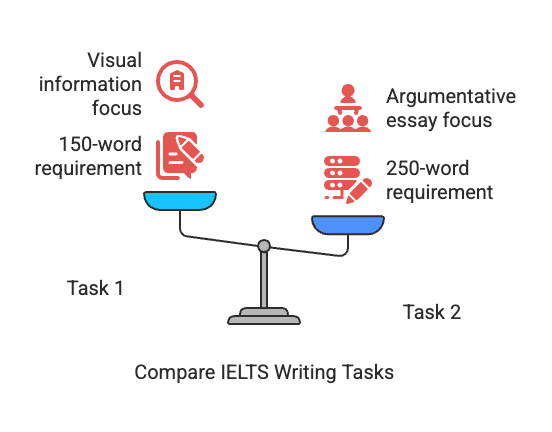Top FAQs: IELTS Academic Writing Test | Writing for Academic IELTS PDF Download
The IELTS Academic Writing Test is designed to assess how well you can express ideas, analyse information, and present arguments in a formal academic style. Below are the 15 most frequently asked questions to help you understand the format, requirements, and scoring of the Academic Writing test.
1. What is the format of the IELTS Academic Writing Test?
The Writing test has two tasks:
Task 1: You will be given a graph, chart, table, diagram, or map and asked to summarise and describe the visual information in at least 150 words.
Task 2: You will write an essay responding to a problem, argument, or opinion in at least 250 words.
You have 60 minutes to complete both tasks.

2. How are the two tasks weighted?
Task 2 is worth twice as much as Task 1. So, your essay carries more weight in your final Writing band score. That’s why it’s recommended to spend 40 minutes on Task 2 and 20 minutes on Task 1.
3. What types of visuals appear in Task 1?
You may be asked to describe:
Line graphs
Bar charts
Pie charts
Tables
Maps (before and after)
Processes (flowcharts or diagrams)
Each type requires a slightly different approach, but your goal is to report the main features and comparisons clearly.
4. Do I need to give my opinion in Task 1?
No. Task 1 requires only factual reporting. You should not include personal opinions or explanations—describe what the data shows.
5. What types of essays appear in Task 2?
Common essay types include:
Opinion essays (agree/disagree)
Discussion essays (discuss both views and give your opinion)
Problem-solution essays
Advantages and disadvantages essays
Two-part questions (e.g., Why is this happening? What are the effects?)
6. How is the Academic Writing test scored?
You are graded on four criteria, each worth 25% of your score:
Task Achievement (Task 1) / Task Response (Task 2)
Coherence and Cohesion (organisation and flow)
Lexical Resource (vocabulary)
Grammatical Range and Accuracy
7. How long should my answers be?
Task 1: At least 150 words
Task 2: At least 250 words
Writing below the word limit will reduce your Task Achievement/Response score. Try to write slightly more (e.g., 160–170 words for Task 1 and 260–280 for Task 2), but stay relevant.
8. Will I be penalised for going off-topic?
Yes. If your response does not address the task or you go off-topic, your score in Task Response may be significantly reduced. Always analyse the question carefully and stay focused.
9. Can I use contractions (e.g., don’t, I’m)?
No. The Academic Writing test requires a formal tone, so avoid contractions, slang, and informal expressions.
10. Can I include personal experiences in Task 2?
Yes, but only when relevant and presented in a formal tone. Avoid storytelling. It’s better to use examples, facts, or reasoning to support your points.
11. How do I structure my essay in Task 2?
A clear and effective structure includes:
Introduction: Paraphrase the question + state your opinion or outline.
Body Paragraphs (usually 2–3): Each with a clear topic sentence, explanation, and example.
Conclusion: Summarise your main points or restate your opinion.
12. Should I include data and comparisons in Task 1?
Absolutely. Your response should highlight:
Key trends or patterns
Significant differences or similarities
Comparisons between time periods or categories
Avoid listing every number—focus on what’s important.
13. Is spelling and punctuation important?
Yes. Mistakes in spelling, punctuation, and grammar will lower your score. You are expected to write with accuracy and clarity.
14. Can I use bullet points or diagrams?
No. All answers must be written in full sentences and paragraph form. Bullet points, notes, or diagrams are not acceptable in either task.
15. How can I improve my Academic Writing score?
Practice regularly with sample questions
Study model essays and reports
Learn to paraphrase effectively
Expand your vocabulary
Focus on organising ideas clearly and developing each paragraph
|
30 videos|206 docs|17 tests
|
FAQs on Top FAQs: IELTS Academic Writing Test - Writing for Academic IELTS
| 1. What is the structure of the IELTS Academic Writing Test? |  |
| 2. How is the IELTS Academic Writing Test scored? |  |
| 3. What types of questions can I expect in Task 2 of the IELTS Academic Writing Test? |  |
| 4. How much time do I have to complete the IELTS Academic Writing Test? |  |
| 5. Are there any recommended strategies for preparing for the IELTS Academic Writing Test? |  |





















